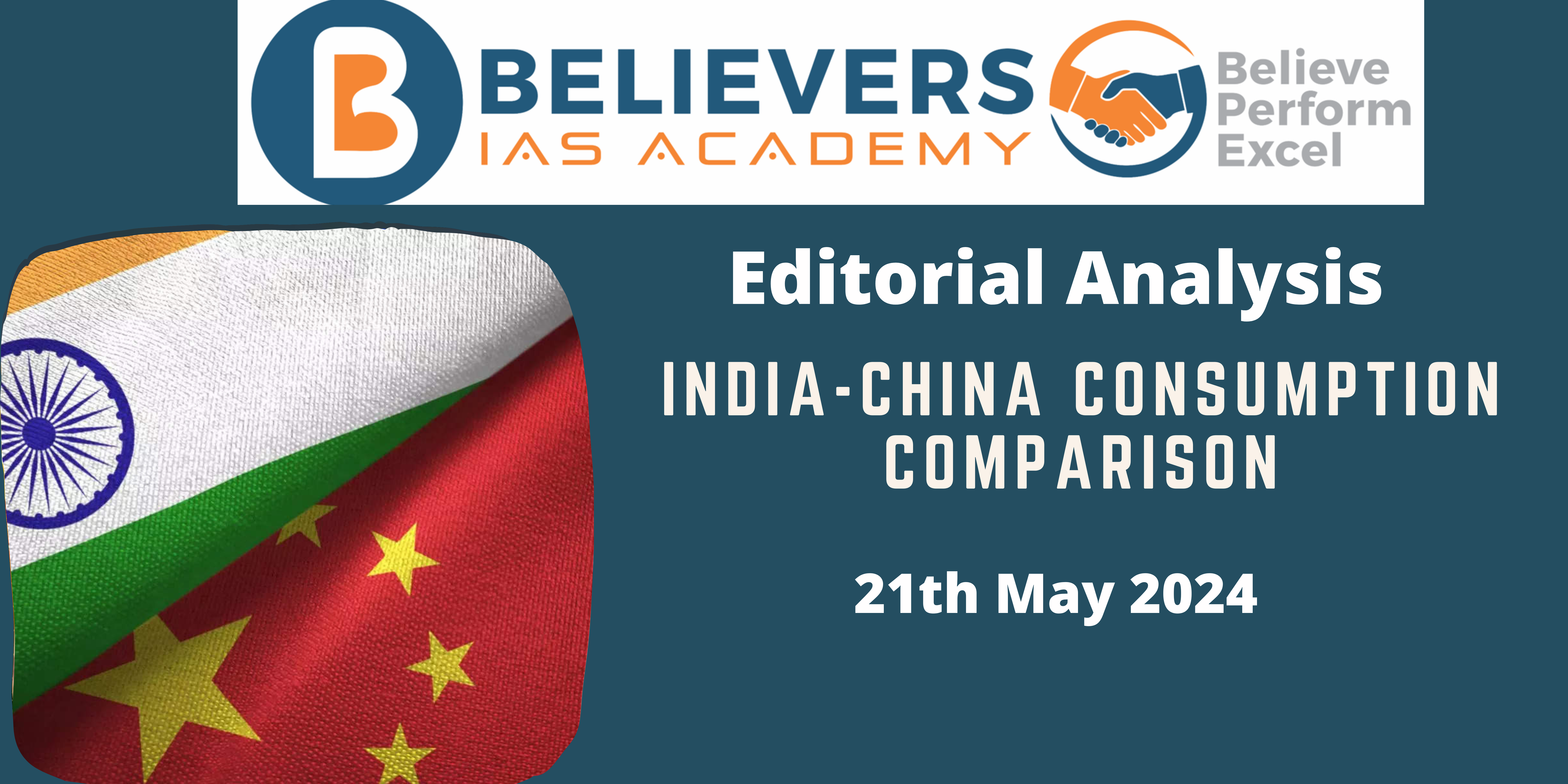India-China consumption comparison
Context:
In 2023, India achieved a significant demographic milestone by surpassing China to become the world’s most populous country. This transition occurs amidst a backdrop of declining birth rates and fertility rates in China, coupled with its first negative population growth in six decades.
- Such demographic shifts suggest a rising dependency ratio in China, which is projected to increase over time.
- In contrast, despite reaching replacement fertility levels, India’s population is anticipated to continue growing and peak around 2060.
Relevance:
GS-01 GS-03 (Population, Growth and Development, Economy)
Dimensions of the Article:
- What is the Topic About?
- What are the Comparisons in Terms of Consumption and Expenditure?
- Challenges and Issues
What is the Topic About?
- The topic explores the consumption and expenditure patterns in India and China, reflecting how demographic shifts influence economic activities in both nations.
- By comparing their Private Final Consumption Expenditure (PFCE), the analysis highlights the differences and similarities in consumer behavior, government spending, and economic priorities.
- This comparison is essential for understanding the economic strengths and weaknesses of India and China in the context of their respective demographic trends.
What are the Comparisons in Terms of Consumption and Expenditure?
1. Private Final Consumption Expenditure (PFCE) as a Measure:
- PFCE is a critical metric for assessing household and non-profit institutions’ spending on goods and services. It provides insight into the consumer spending patterns within an economy, reflecting the living standards and economic activity levels.
- India vs. China PFCE Contribution to GDP:
- In India, PFCE contributes over 58% to the GDP, whereas, in China, it constitutes only 38% of the GDP. This indicates that consumption is a more significant driver of economic growth in India compared to China, where investment and exports play a larger role.
- Final consumption, which includes government expenditure, makes up 68% of India’s GDP and 53% of China’s GDP. This underscores the more substantial role of government consumption in China’s economy.
2. Aggregate PFCE Figures:
- Despite China’s economy being roughly five times larger than India’s, its PFCE is only about 3.5 times greater. This suggests that India’s economy, though smaller, relies more heavily on domestic consumption.
- India’s PFCE has steadily increased from $1.64 trillion in 2018 to $2.10 trillion in 2022. In contrast, China saw a slight decline in PFCE from $6.8 trillion in 2021 to $6.6 trillion in 2022, reflecting economic challenges and demographic pressures.
3. Per Capita PFCE:
- The gap in per capita PFCE between India and China has widened marginally, with China’s per capita PFCE being approximately 3.1 times that of India in 2022, up from 3.0 times in 2018. This gap reflects the higher standard of living and greater consumer spending power in China.
4. Purchasing Power Parity (PPP) Adjustments:
- When adjusted for PPP, the gap between India and China’s PFCE narrows further. China’s PFCE is about 1.5 times that of India’s when measured in PPP terms. This adjustment accounts for the cost of living differences, providing a more accurate comparison of actual consumption levels.
Challenges and Issues:
1. Demographic Shifts and Economic Impact:
- Aging Population in China: The declining birth rate and negative population growth in China suggest a future increase in the dependency ratio, which could strain social services and reduce the working-age population, impacting economic productivity.
- Growing Youth Population in India: While India’s demographic dividend presents opportunities, it also poses challenges in terms of providing adequate education, employment, and healthcare services to a young and expanding population.
2. Consumption Patterns:
- India’s Consumption Basket: Higher spending on essentials like food, clothing, and transport reflects the characteristics of a developing economy. Lower spending on education, healthcare, and recreation suggests potential areas for growth and improvement.
- China’s Consumption Basket: The transition towards higher spending on housing, education, healthcare, and recreation indicates a maturing market. However, the declining share of food and beverages expenditure points to changing consumer priorities.
3. Economic Disparities:
- The significant difference in PFCE as a percentage of GDP between India and China highlights the contrasting economic structures. India’s consumption-driven growth model contrasts with China’s investment and export-led growth, which may face sustainability challenges amid demographic changes.
4. Policy and Structural Challenges:
- India: Addressing the needs of a growing population while enhancing consumer spending power through improved economic policies, infrastructure, and social services.
- China: Managing the economic implications of an aging population, reducing dependency on government consumption, and fostering sustainable domestic consumption growth.
Suggested Measures:
1. Strengthen Economic Policies:
- India:
- Enhance job creation and skill development programs to leverage the youthful demographic.
- Improve infrastructure and healthcare services to support growing consumption demands.
- Promote financial inclusion and access to credit to boost consumer spending.
- China:
- Implement policies to support elderly care and social security systems to manage the aging population.
- Encourage domestic consumption through incentives and subsidies.
- Diversify the economy to reduce reliance on government consumption and promote private sector growth.
2. Foster Sustainable Consumption:
- Promote awareness and adoption of sustainable consumption practices to ensure long-term economic and environmental health.
- Invest in renewable energy and green technologies to support sustainable economic growth.
3. Enhance Education and Healthcare:
- India:
- Increase investment in education and vocational training to improve human capital.
- Expand healthcare services to meet the needs of a growing population and reduce out-of-pocket expenses.
- China:
- Continue reforms in the education sector to enhance quality and accessibility.
- Strengthen healthcare infrastructure to support an aging population and reduce disparities.
4. Encourage Innovation and Technology:
- Invest in research and development to drive innovation and economic growth.
- Promote digital inclusion and the adoption of new technologies to enhance productivity and consumer experiences.
5. Address Income Inequality:
- Implement policies to reduce income inequality and ensure equitable growth.
- Provide social safety nets and support for vulnerable populations to enhance social stability and economic resilience.




